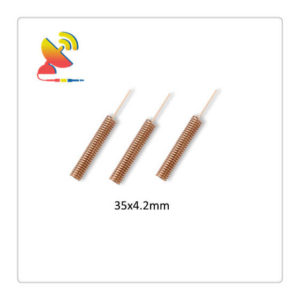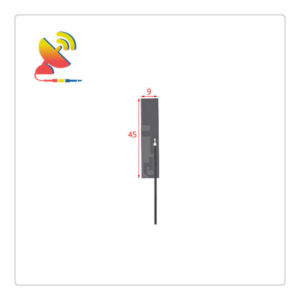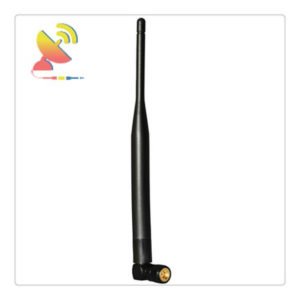Description
What is a GSM Antenna Base Station Sector Antenna For Telecommunication?
The GSM antenna CTBS-8096-12D65VBZ-002 sector antenna is an 806-960MHz 12dBi high gain base station antenna, that is ideal as a base station or access point antenna for wireless GSM applications. The GSM antenna measures 600*280*125mm and comes with N-type female connectors.
This GSM antenna has 2 ports and ±45-degree dual slant polarization. It delivers reliable coverage while penetrating dense foliage and can handle an input power of up to 50 watts.
The GSM Antenna Base Station Sector Antenna For Telecommunication outdoor antenna is provided by C&T RF Antennas Inc. A leading indoor outdoor antenna manufacturer in China.
C&T RF Antennas Inc provides internal & external antennas with antenna radio frequencies such as NFC, 169MHz, 230MHz, 315MHz, 433MHz, 868MHz, 915MHz, VHF&UHF, Lora, NB-IoT, ADS-B, GSM, GNSS, GPRS, 1.2 GHz, 1.4 GHz, 1.8 GHz, Wi-Fi 2.4 GHz, 5.8 GHz, Cellular 2G, 3G, 3.5 GHz, 4G LTE, GPS, 5G NR, 6G, etc.
C&T RF Antennas Inc. provides RF antennae with Omni & Directional antenna types such as Dipole Antennas, Whip Antennas, Marine Antennas, Router Antennas, MIMO Antennas, Combo Antennas, PCB Antennas, FPC Antennas, Spring Antennas, Magnetic Antennas, Sector Antennas, Yagi Antennas, and Accessories, etc, for IoT & M2M industries.
The GSM Antenna Base Station Sector Antenna For Telecommunication is supplied by C&T RF Antennas Inc, the indoor GSM Antenna and outdoor GSM Antenna manufacturer in China, contact us for the GSM Antenna Base Station Sector Antenna datasheet, GSM Antenna pricing, GSM Antenna inventory, or other GSM Antenna types.
Sector GSM Antenna Base Station Antenna Specifications
GSM Antenna Sector Antenna Electrical Specifications |
|
| RF Antenna Type | Sector Antenna |
| Model | CTBS-8096-12D65VBZ-002 |
| Frequency | 806-960MHz |
| Gain | 12dBi |
| VSWR | ≤2.0 |
| Impedance | 50 Ω |
| Polarization | Dual Slant (45 Degrees) |
| Horizontal Beam Width | 65°±10° |
| Vertical Beam Width | 35°±5° 25°±10° |
| Connector | N-Type Female |
| Max Power | 50W |
| Lightning Protection | DC Ground |
| Directionality | Directional |
GSM Antenna Sector Antenna Mechanical Specifications |
|
| Dimension | 600*280*125mm |
| Front-to-Back Ratio | ≥23dB |
| Port to Port Isolation | ≥25dB |
| Storage Temperature Range | -40~+70°C |
| Working Temperature Range | -40~+65°C |
| PIM Test | (2@43dBm) ≤-150dBc |
| Color | Warm White |
| Antenna Form | Single Band |
| Mounting | Pole Mount |
| RoHS | Compliant |
| Applications | GSM, RFID, IoT/NB-IoT/LoRa |
What is a Base Station Antenna?
WCDMA (3G) base station antenna GSM antenna
Spread spectrum and modulation technology: support multiple spreading factors, adopt QPSK modulation technology, easy to generate code resources, good anti-interference, and provide sufficient code resources
Features
1. Spread spectrum and modulation technology: support a variety of spreading factors, adopt QPSK modulation technology, easy to generate code resources, good anti-interference, and provide sufficient code resources
2. Because WCDMA uses a higher spreading code rate, the WCDMA system has high receiving sensitivity, enabling the base station to cover longer distances, and effectively reducing network construction costs;
3. Due to the higher radio frequency bandwidth and spreading code rate, WCDMA reduces the number of radiofrequency components of the base station under the same channel capacity, thereby reducing the overall cost per channel
4. Transmit diversity technology: support multiple transmit diversity methods such as TSTDSTTDSSDT, effectively improve wireless link performance, in order to improve downlink coverage and capacity, leaving a lot of room for future DL planning after the business comes up, it is an important new Technology one
5. Compressed mode technology: no information is sent in certain time slots in one or several consecutive radio frames, mainly used for inter-frequency measurement and inter-system switching, which can better realize the switching between WCDMA and GSM systems and improve the service of operators’ quality
It is easy to build a station, easy to maintain, wider frequency point, more sufficient multiplexing, good voice quality, soft handover, and good confidentiality.
TDD-LTE base station antenna
It has the reciprocity of uplink and downlink channels, and can better adapt transmission pre-processing technologies, such as pre-RAKE technology, joint transmission (JT) technology, smart antenna technology, etc., which can effectively reduce the processing complexity of mobile terminals
Features
1. The frequency can be flexibly configured, and the scattered frequency bands that are not easy to use by the FDD system are used
2. The ratio of downlink time slots can be increased by adjusting the conversion point of uplink and downlink time slots, which can support asymmetric services
3. With the consistency of uplink and downlink channels, the base station can share part of the radio frequency unit for receiving/transmitting, reducing equipment costs
4. When receiving uplink and downlink data, no transceiving isolator is needed, only a switch is needed, which reduces the complexity of the device
5. With the reciprocity of the uplink and downlink channels, it can better adapt transmission preprocessing technologies, such as pre-RAKE technology, joint transmission (JT) technology, smart antenna technology, etc., which can effectively reduce the processing complexity of mobile terminals.
TD-SCMA (3G) base station antenna
TD-SCMA antenna is a standard of 3G (third-generation mobile communication system) and an evolution of the GSM standard. It uses a time division duplex, TDMA/CDMA multiple access working modes, and its goal is to establish a high spectrum efficiency. High economic efficiency and advanced mobile communication system
Features
TD-SCMA antenna is a standard of 3G (third-generation mobile communication system) and an evolution of the GSM standard. It uses a time division duplex, TDMA/CDMA multiple access working modes, and its goal is to establish a high spectrum efficiency. High economic efficiency and advanced mobile communication system.
GSM antenna (2G) base station antenna
GSM is a cellular network, which means that the mobile phone must be connected to the cell area that it can search for. GSM network runs on multiple different radio frequencies
GSM antenna Features
GSM is a cellular network, which means that the mobile phone must connect to the cell area that it can search for. The GSM network runs on many different radio frequencies.
There are 4 different cell sizes in the GSM network: giant cells, microcells, picocells, and umbrella cells. The coverage area varies with different environments. Giant cells can be regarded as the kind of base station antennas installed on masts or on top of buildings.
Microcells are those whose antenna height is lower than the average building height and are generally used in urban areas. Pico cells are very small cells that only cover a range of tens of meters and are mainly used indoors. Umbrella honeycombs are used to cover the blind areas of smaller honeycomb networks and fill the signal-blank areas between cells.
The cell radius can range from hundreds of meters to dozens of kilometers depending on antenna height, gain, and propagation conditions. The long-distance GSM specification actually supports up to 35 kilometers. There is also the concept of expanding the honeycomb. The radius of the honeycomb can be doubled or more.
GSM also supports indoor coverage, and the power of the outdoor antenna can be distributed to the indoor antenna distribution system through the power divider. This is a typical configuration scheme, used to meet the requirements of indoor high-density calls, and is very common in shopping malls and airports.
However, this is not necessary, because indoor coverage can also be achieved through unlimited signals passing through buildings, but this can improve signal quality and reduce interference and echo. High power, good call quality, convenient station construction, easy maintenance, clear call, and good confidentiality.
FDD-LTE base station antenna
The FDD mode is to receive and transmit on two separate symmetrical frequency channels and use the guard band to separate the receiving and transmitting. FDD must use paired frequencies. The system receives and transmits on two symmetrical channels. The frequency is wide and the data And the transmission speed is fast, which can be used to improve the spectrum utilization rate and increase the system capacity
Features
The FDD mode is to receive and transmit on two separate symmetrical frequency channels, and use the guard band to separate the receiving and transmitting. FDD must use paired frequencies. The system receives and transmits on two symmetrical channels. The frequency is wide, and the data And the transmission speed is fast, which can be used to improve the spectrum utilization rate and increase the system capacity.
LTE is a 3GPP long-term evolution project, compatible with the current 3G communication system and 3G evolution. It has the characteristics of a high transmission rate, high transmission quality and high mobility, convenient station construction, easy maintenance, clear calls, and good confidentiality.
FAD base station antenna
Carry out time/space/frequency three-dimensional fast wireless resource scheduling to ensure system throughput and quality of service; convenient site construction, easy maintenance, saving subsequent D-band antenna deployment investment, and reducing site construction costs.
Features
1. Flexible support 1, 3, 5, 10, 15, 20MHz bandwidth;
2. Using OFDMA in the downlink, the high rate reaches 100Mbits/s, meeting the requirements of high-speed data transmission;
3. The uplink uses OFDM derivative technology SC-FDMA (Single Carrier Frequency Division Multiplexing), which can effectively reduce the peak-to-average ratio (PAPR) while ensuring system performance, reducing terminal transmission power, and extending the use time. The uplink rate reaches 50Mbits/ s;
4. Make full use of the characteristics of TDD such as channel symmetry to simplify system design while improving system performance;
5. The high level of the system is generally consistent with the FDD system;
6. Combine smart antennas with MIMO technology to improve the performance of the system in different application scenarios;
7. Apply smart antenna technology to reduce inter-cell interference and improve the quality of service for users at the edge of the cell;
8. Carry out time/space/frequency three-dimensional fast wireless resource scheduling to ensure system throughput and service quality.
9. It is convenient to build a station, easy to maintain, saves subsequent D-band antenna deployment investment, and reduces the cost of building a station.
FA-D Independent ESC Smart Base Station Antenna
Features
1. Flexible support 1, 3, 5, 10, 15, 20MHz bandwidth;
2. Using OFDMA in the downlink, the high rate reaches 100Mbits/s, meeting the requirements of high-speed data transmission;
3. The uplink uses OFDM derivative technology SC-FDMA (Single Carrier Frequency Division Multiplexing), which can effectively reduce the peak-to-average ratio (PAPR) while ensuring system performance, reducing terminal transmission power, and extending the use time. The uplink rate reaches 50Mbits/ s;
4. Make full use of the characteristics of TDD such as channel symmetry to simplify system design while improving system performance;
5. The high level of the system is generally consistent with the FDD system;
6. Combine smart antennas with MIMO technology to improve the performance of the system in different application scenarios;
7. Apply smart antenna technology to reduce inter-cell interference and improve the quality of service for users at the edge of the cell;
8. Carry out time/space/frequency three-dimensional fast wireless resource scheduling to ensure system throughput and service quality.
9. It is convenient to build a station, easy to maintain, saves subsequent D-band antenna deployment investment, and reduces the cost of building a station.
DCS, DTS (2G) base station antenna
The control function is strong, the system reliability is high, the CRT operating station has a good man-machine interface, the software and hardware use the modular building block structure, the system is easy to develop, the configuration software is simple to program, the operation is convenient, and the price is good!
It is convenient to build a website, easy to maintain, clear calls, and good confidentiality.
CDMA2000 (3G) base station antenna
The upgrade time is short, and the upgrade of GSM to WCDMA and TD-SCDMA is almost a rebuilding of the network to achieve a national coverage network
Features
1. The upgrade time is short. The upgrade of GSM to WCDMA and TD-SCDMA is almost a reconstruction of the network. The time required to realize the commercial coverage of the nationwide network is estimated to be 2 and 3 years respectively. The CDMA upgrade time is calculated in months, which has the advantage of about one and a half years ahead.
2. Low cost, protecting the interests of online investors. The cost of a CDMA upgrade is about 1/3 of that of a new network, and the cost of network construction has obvious advantages.
3. It is conducive to developing market business and protecting the interests of consumers. The development of market services and users are gradually upgrading, and users do not want to change phones frequently due to network upgrades.
The backward compatibility of CDMA ensures that old phones can be used in upgraded networks, while other networks often use dual-mode to dual-network to realize. The voice capacity of each sector of CDMA2000 can reach 120 simultaneous calls, which is about three times that of the current system.
CDMA(2G) base station antenna
CDMA (2G) base station antennas have the advantages of convenient station construction, easy maintenance, large coverage area, high spectrum utilization, simple network planning, flexible system capacity configuration, soft handover, clear calls, and good confidentiality.
Multi-band base station antenna (support 2, 3, 4G at the same time)
Features
The multi-band antenna meets the requirements of the FDD+TDD multi-network co-construction of three operators, or the 2G+3G+4G multi-mode co-site requirement of the same operator. Connecting the driver and controller can remotely control or background control the antenna coverage area. Currently, common antenna, multi-standard, and miniaturized antennas are increasingly favored by operators.
Compared with multiple single antennas, the use of multi-mode antennas reduces the antenna cost by 1/3, reduces the number of antennas, reduces the load on the tower, and reduces the cost of site construction.
Logarithmic antenna
Log periodic antennas are mainly used in the ultra-short wave band, and can also be used as short-wave communication antennas and medium-wave and short-wave broadcast transmitting antennas.
High efficiency, close to the expected value of emission, compared with other high-gain antennas, the log-period antenna has stronger directivity, convenient station construction, and easy maintenance.
Omnidirectional base station antenna
An omnidirectional antenna, that is, shows uniform radiation at 360° on the horizontal pattern, which is commonly referred to as non-directional and shows a beam with a certain width on the vertical pattern. In general, the smaller the lobe width, the greater the gain.
Omnidirectional antennas are generally used in the station type of suburbs and counties in mobile communication systems, with large coverage, convenient station construction, and easy maintenance.
Base stations are a great way to stay connected, especially during an emergency. Here, you will find a variety of base station antenna options to choose from Indoor and/or Outdoor Base Station Antennas, Omnidirectional Base Station Antennas, VHF Base Station Antennas, Yagi Antennas, Discone Antennas, and More!
Connect C&T RF Antennas Inc. for more base station antenna styles.






Reviews
There are no reviews yet.